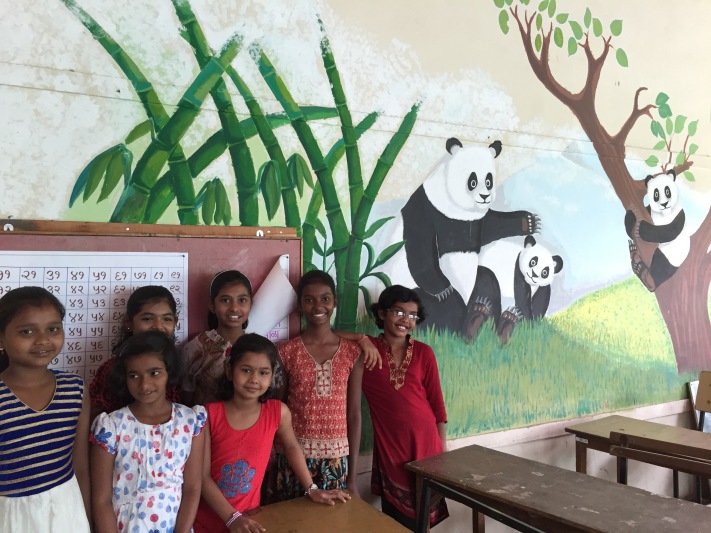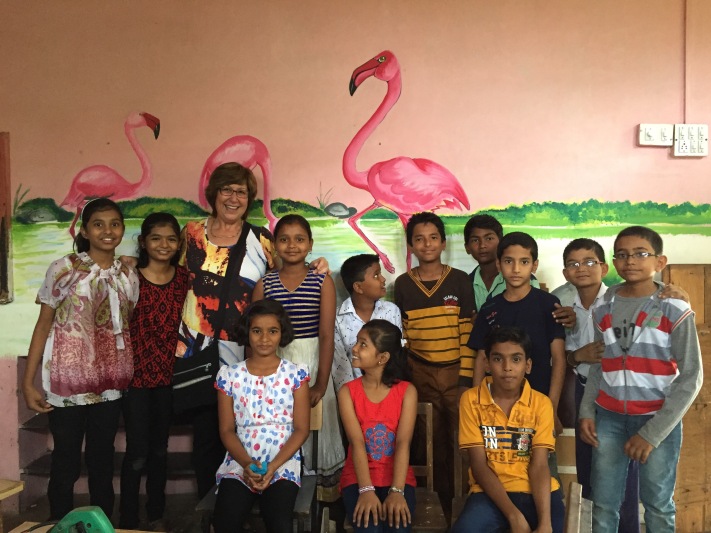Guest post by Jackie Barrow who has been involved in the SOLE and SOME project for over three years. During that time she has interacted with different groups of children in a variety of locations in India.
My relationship with Khelghar Palakneeti, a charity run after school provision for the children of the Lakshminagar slum of Pune, began well over a year ago. Their unwavering commitment to the SOLE project is what makes it work so well. For one hour a week, the children are permitted to use the office computer in order to connect with me. No, of course it doesn’t always run smoothly! There are all the usual frustrations; poor connections, no sound, no video, no children, no staff, monsoon rains, holidays and festivals at both ends meaning we’re not around. But when sessions don’t or can’t take place for any reason, we let each other know. This continuity has allowed me to build a real relationship with the children and staff.
An opportunity…
Back in April a film crew from the BBC’s Technology Website came to film me Skyping my group at Khelghar and talking about my involvement in the SOLE and SOME project. Following on from this, the BBC’s One Show, a magazine style programme, proposed a trip to Pune to meet and film with my group of children. I am sure you can imagine how thrilled I was. This was an opportunity not to be missed.
I had no reservations about the trip itself but I did have reservations about the filming. I was worried that the cameras would be intrusive and alter the nature of my interaction with the children. We were to visit the slum where the children live and meet with their families. I thought maybe this would seem somewhat voyeuristic and that the slum dwellers might resent our presence.
However, I need not have worried. The two young men who made up the film crew had both visited India before and were as excited as I was about the project. They quickly became favourites with both the staff and the children and although they and the cameras were ever present, none of us felt inhibited by their presence. Well, that’s not entirely true. I did! Not when I was reading stories, teaching felting or just chatting with the children, but I found the ‘interviews’ more difficult and the constant need to try to articulate how I was feeling.
How was I feeling? Well, just completely overwhelmed by the scale of the problems they are faced with and by the fantastic work going on at Khelghar. I will leave you to read more about Khelghar Palakneeti, but let me tell you how inspiring women like Shubhada Joshi and her team of staff and volunteers are. Some have themselves grown up in the slums of Pune but have managed not only get a basic education but to go on to higher education. Not content with just improving their own lives and prospects, they work to support children and their families, helping them see that education is a way out of the trap of poverty. I felt very proud to be associated with these women and to play my own, very small, part in their project.
Meeting the children…
So how was it, meeting the children? I must confess that I began to feel quite nervous. What were they expecting? Would I prove to be a disappointment, this so-called ‘granny’ from England? I learnt later from Suneeta that they were nervous too! Would they be able to understand me? Would they know what to say? But nerves were soon forgotten on both sides. I had decided to just carry on from the Skype session the week before, when we had been talking about the 2012 London Olympics. Within minutes we were on our hands and knees, sorting and matching pairs of cards. I followed this with a story they knew, Mr. Gumpy’s Outing by John Burningham but instead of just reading it, we acted it out. Their level of participation far outstripped what I had hoped for. I had a second session with the children a couple of days later, a practical activity, teaching them how to make felt. The plan was to make some bunting with the word Khelghar. So we set to with wool, water and soap to create and decorate our felt. Once again, the children threw themselves into the session and although we didn’t quite achieve the finished article at the time, they have shown it to me today, three weeks later, over Skype. Fantastic!
This second session took place in the slum. Khelghar has two small buildings there where they hold classes for groups of girls and younger children. I thought that entering the slum might feel quite intimidating. The piles of rubbish being picked over by birds, cats and people, and the volley of barking from the thin, scabby looking dogs, is hardly welcoming. However, once again, I need not have worried. Whether it was the presence of the cameras, or the respect with which Suneeta Kulkarni and the staff and volunteers from Khelghar, are held within this community, I am not sure. We were greeted with friendly curiosity. People waved, called out greetings and warned us of holes, puddles and mopeds. It was wonderful to see how Suneeta was greeted by the children of the slums of Pune, one little girl rushing down the hill all smiles to throw her arms around Suneeta Tai. Children walked with us up the steep, treacherous lanes between the dwellings.
Homes tend to be a single room, sometimes with a foundation of stone or brick, generally finished with wood or corrugated iron. They house the cooking equipment, sometimes the moped, a small shrine, some clothes storage and a large wooden family bed with a thin mattress. There is no running water inside, though an unreliable electricity supply is delivered across a tangle of wires. The people are construction workers, often the women too. The mother of one of my regulars, a woman of 36, is ill and waiting for her husband to be paid before she can collect her medicine. She has spent the last twenty years carrying bags of sand and cement on building sites. She would be beautiful if she were not so thin and drawn. She is determined that her son will finish his education and have opportunities that she and her husband have not had. In an interview with him earlier, he told us that he wants to be a car mechanic, which is certainly achievable.
So what the BBC’s One Show viewers will make of my experience, I’m not too sure. I hope that the films will not only give a true idea of the vision of Professor Sugata Mitra but will do justice to the efforts of all those who make such a difference to the lives of children on a daily basis. As for me, well I count myself extremely lucky to have had this opportunity and hope very much that I can use it to further support the work of the project. And of course, I will always have a particular interest in the work of Khelghar Palakneeti and in the futures of the children I have met there.
Related posts:
Play House
Opening New Vistas
Teacher as learner















